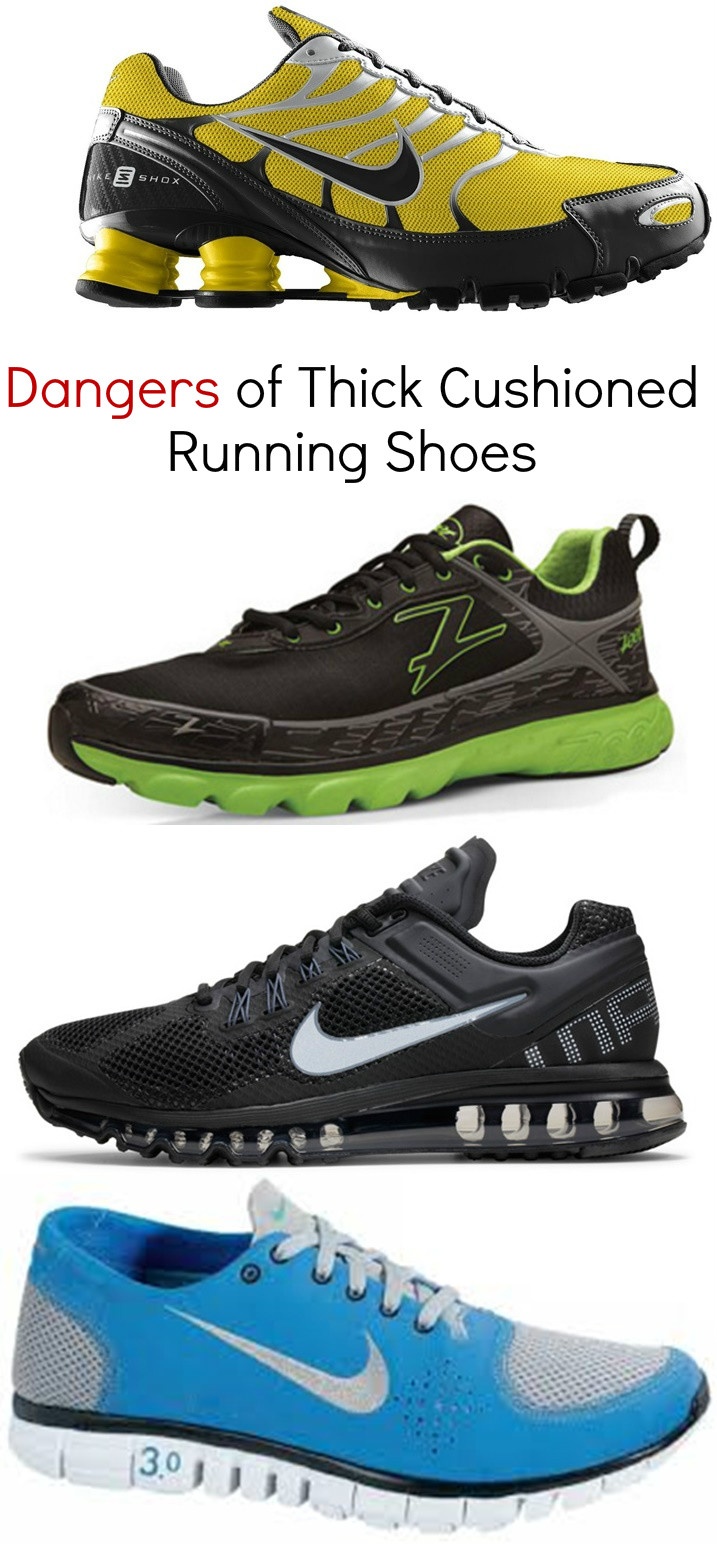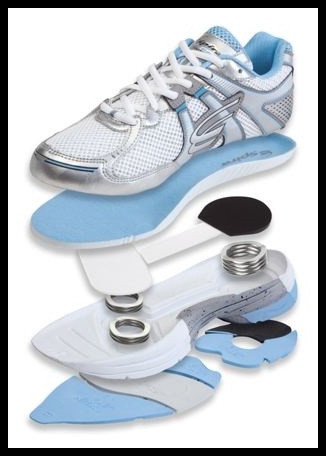When it comes to preventing running injuries, there are many drawbacks to cushioned running shoes in that instead of reducing impact, thicker padding causes more impact production and produces mechanics that cause the leg, namely the knee, harm. Not just that, the inflexibility and narrow, unergonomic fit of most cushioned running shoes leads to deteriorating health and function of the foot, whereby if your feet are weak, you can expect some injury setbacks along the way! This is how thick cushioned running shoes damages multiple areas of the body at the same time.

Consistent with the research, thick cushioned running shoes are no way to make progress in preventing injuries. This is because researchers discovered that thick cushioned running shoes cause mechanical imbalances and misalignments of the ankle, knee and hips and more rigid landings in the form of a heel strike, which is the main source of high stress as compared with forefoot striking. Whats worse, the impact of heel strike running is enhanced with increased shoe cushioning!
How Cushioned Running Shoes Cause Heel Striking, And Too Much Impact
The big reason cushioned running shoes causes heel strike when running is the raised cushioned heel aligns the foot in a difficult position, coupled with the loss of ground-feel, causes the foot to over-reach ahead of the hips which also causes the knee-joint to unbend and stiffly lock out, shown below:

This is how a large cushioned-heeled running shoe can push your mechanics out of a safer range, resulting in knee extension (unbent knee) and ankle dorsiflexion (fancy term for heel striking), all of which increases joint loading and peak and mean shock values on the shin.

Moreover, a study in the journal, Footwear Science, indicated more mechanical consequences caused by thick cushioned running shoes which included longer ground-contact time, greater peak push-off, greater concentric knee power and over striding during running. Worse still, a similar study found that habitual minimalist runners who ran with a forefoot strike adopted a heel strike in thick cushioned running shoes. Their findings have since been replicated numerous times in other studies.
Sadly, these are all normal accompaniments of running in cushioned running shoes, and is why more are taking minimalist shoes and barefoot running seriously.
Why Minimalist Shoes and Being Barefoot Are Best For Improving Form
Because of the high injury rates, many injured runners are looking to barefoot and minimalist running because both conditions take the lead in the research for leading to quickest and largest improvements in your entire mechanics, from head to toe! This is because our reflexive and neuromuscular responses changes with what we wear, or don’t wear on our feet. Here’s why:

The strong, multiple sensory inputs stimulating the bare-foot leads to faster withdrawal times of the foot (higher step-rate), greater mental and reflexive control of a proper forefoot strike, stronger balance control and prevents an over-stride by encouraging you to pull back more with your foot, rather than rushing the foot down at landing. At the same time, barefoot and minimalist running increases intrinsic development of stronger foot muscles by allowing the foot to work independently, which is the most effective way to keep your feet strong.
The Take Home Message
Given the pronounced positive effects barefoot and minimalist running has on improving motor performance and learning, these 2 running conditions are the ultimate mechanical re-calibrator that will make it easier for you to handle longer, harder and faster miles, with far less impact!
Even more encouraging, barefoot and minimalist running produces a constant stream of muscle tone to promote more soft tissue growth, leading to the greatest improvements in age-proofing the feet. Read more here about all the evidence-bases reason barefoot and minimalist running will help your run better in regular running shoes!
If you enjoyed my blog post, you’ll love my YouTube channel, here, where I talk about why forefoot running is the safer and faster way to run vs heel strike running.

References:
Flemming et al. Acute response to barefoot running in habitually shod males. Hum Mov Sci, 2015; 42:27-37.
Paquette et al. Acute effects of barefoot, minimal shoes and running shoes on lower limb mechanics in rear and forefoot strike runners. Footwear Sci, 2013; 5(1):9-18.
Robbins, S. E., & Hanna, A. M. (1987). Running-related injury prevention through barefoot adaptations. Medicine & Science in Sports & Exercise, 19, 148–156.
Tung, KD., Franz, JR and Kram, R. A test of the metabolic cost of cushioning hypothesis during shod and unshod running. Med Sci Sports Exerc, 2014; 46(2):324-9.
Run Forefoot Because You are Faster than You Think!

Bretta Riches
BSc Neurobiology; MSc Biomechanics candidate, ultra minimalist runner & founder of RunForefoot. I was a heel striker, always injured. I was inspired by the great Tirunesh Dibaba to try forefoot running. Now, I'm injury free. This is why I launched Run Forefoot, to advocate the health & performance benefits of forefoot running and to raise awareness on the dangers of heel striking, because the world needs to know.
Latest posts by Bretta Riches (see all)
- Can You Run In Barefoot Shoes? Yes, But DON’T Heel Strike! - 21/07/2024
- Why Cushioned Running Shoes Are Really Bad for Your Feet - 19/07/2024
- Do Cushioned Running Shoes Cause Injuries? - 17/07/2024
